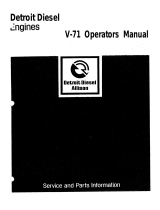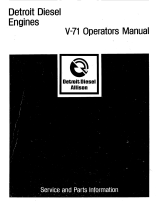
Table of Contents
1 Safety
1.1 Important provisions for all products 5
1.2 Personnel and organizational requirements 6
1.3 Transport 7
1.4 Crankshaft transport locking device 8
1.5 Crankshaft transportation lock – For
transport with flange-mounted generator 10
1.6 Safety regulations for startup and operation 12
1.7 Safety regulations for maintenance and
repair work 13
1.8 Fire prevention and environmental
protection, fluids and lubricants, auxiliary
materials 16
1.9 Standards for safety notices in the text 18
2 General Information
2.1 Engine side and cylinder designations 19
2.2 Engine layout 20
2.3 Sensors and actuators – Overview 21
3 Technical Data
3.1 12/16 V 4000 C13/13R/13L engine data:
Application group 5A, optimized fuel
consumption 25
3.2 12/16 V 4000 C13/13R/13L engine data:
Application group 5A, optimized exhaust
emissions (EPA Stage 2) 32
3.3 12/16 V 4000 C23/23R engine data:
Application group 5B, optimized fuel
consumption 39
3.4 12/16 V 4000 C23/23R engine data:
Application group 5B, optimized exhaust
emissions (EPA Stage 2) 43
3.5 Firing order 47
3.6 Main engine dimensions 48
4 Operation
4.1 Preparations for recommissioning the
engine after extended out-of-service periods
(>3 months) 49
4.2 Putting the engine into operation after
scheduled out-of-service-period 50
4.3 Starting the engine in manual mode 51
4.4 Stopping the engine in manual mode 52
4.5 After shutting down the engine 53
4.6 Plant cleaning 54
5 Maintenance
5.1 Maintenance task reference table [QL1] 55
6 Troubleshooting
6.1 Troubleshooting 56
6.2 Fault messages of the engine governor
ADEC (ECU 7) for series 4000 C&I engines 59
7 Task Description
7.1 Engine 78
7.1.1 Cranking engine manually 78
7.1.2 Engine – Barring with starting system 80
7.2 Cylinder Liner 81
7.2.1 Cylinder liner – Endoscopic examination 81
7.2.2 Instructions and comments on endoscopic and
visual examination of cylinder liners 83
7.3 Crankcase Breather 85
7.3.1 Crankcase breather – Oil separator element
replacement, diaphragm check and
replacement 85
7.4 Running Gear 87
7.4.1 Grounding device – Carbon brush check 87
7.4.2 Grounding device – Carbon brush replacement 89
7.5 Valve Drive 90
7.5.1 Valve gear – Lubrication 90
7.5.2 Valve clearance – Check and adjustment 91
7.5.3 Cylinder head cover – Removal and
installation 95
7.6 Injection Pump / HP Pump 96
7.6.1 HP pump – Filling with engine oil 96
7.7 Injection Valve / Injector 97
7.7.1 Injector – Replacement 97
7.7.2 Injector – Removal and installation 98
7.8 Fuel System 103
7.8.1 Fuel system – Venting 103
7.9 Fuel Filter 104
7.9.1 Fuel filter – Replacement 104
7.9.2 Draining fuel prefilter 105
7.9.3 Fuel prefilter – Draining 106
7.10 Charge-Air Cooling 107
7.10.1 Intercooler – Checking condensate drain for
coolant discharge and obstructions 107
7.11 Air Intake 108
7.11.1 Service indicator – Signal ring position check 108
7.12 Starting Equipment 109
M015695/03E 2013-03 | Table of Contents | 3
DCL-ID: 0000013811 - 005





















